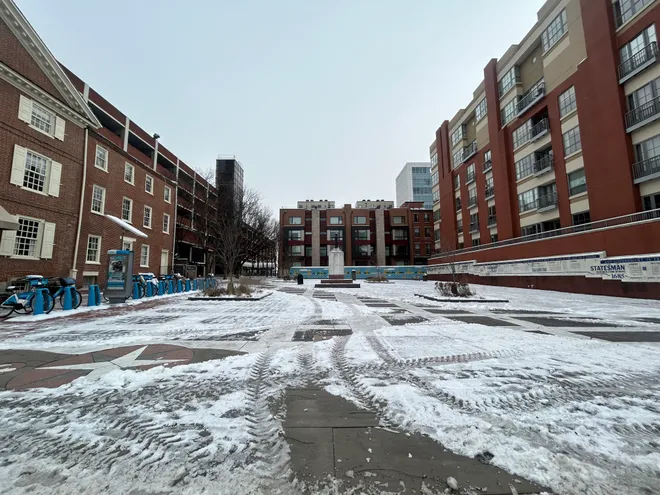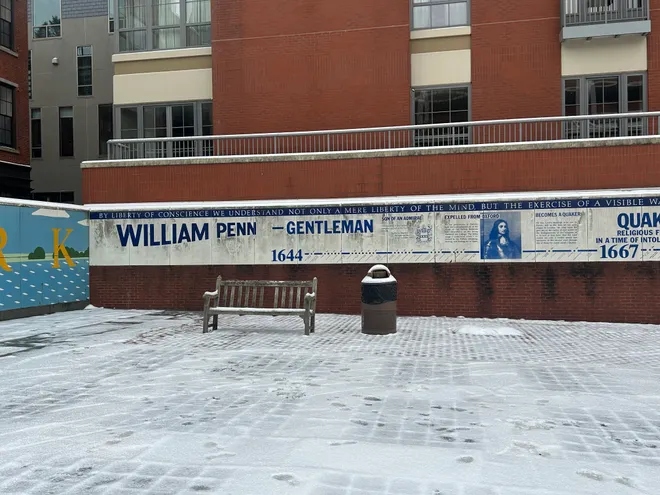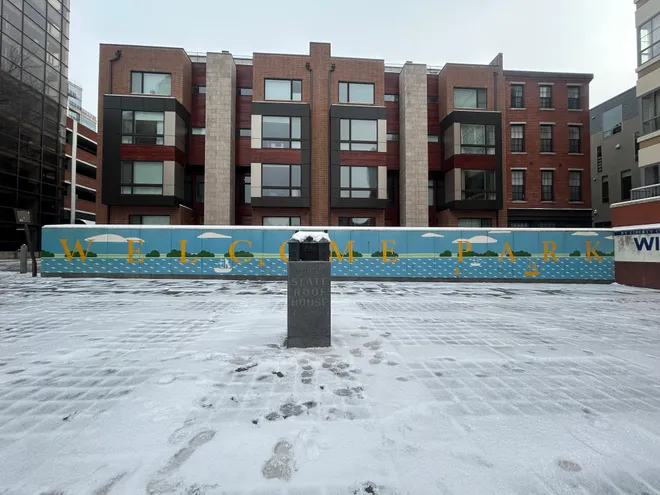Native tribes don't want statue of William Penn removed. They want their story told.

PHILADELPHIA — It was never about William Penn, members of Native American tribes say.
Their discussions with the National Park Service centered around proper representation of their nations and the deep history they have in the Philadelphia region, and at Welcome Park in particular: The parcel in the heart of Philadelphia's Old City, created in 1982 to honor the Quaker who founded Pennsylvania, is an open-air museum that tells Penn's story on a stone model of the city's original street grid.
In early January, the National Park Service issued a news release asking for public input to "provide a more welcoming, accurate and inclusive experience for visitors" at Welcome Park, adding benches, plantings and signage honoring Native American tribes who called the area home when Penn arrived.
But the release also mentioned permanent removal of a statue of William Penn and a small model of his Slate Roof House, where he lived from 1699-1701. And that set off a social media firestorm: State and national officials from both parties criticized the proposal, which was quickly withdrawn by the National Park Service.
The controversy comes amid a national reckoning over whose legacies should be honored and how to accurately reflect history, one that has drawn its own backlash.
"The preliminary draft proposal, which was released prematurely and had not been subject to a complete internal agency review, is being retracted," the NPS said in another news release days later withdrawing the proposal. "No changes to the William Penn statue are planned."
Tribal officials told USA TODAY they are still puzzled by the uproar, saying none of them asked or advocated for removal of Penn's statue. Instead, they said, they simply wanted to make the park more inviting to the public and a place where they could gather as they once did.
"We want to show the ways in which we shaped what the city became," Jeremy Johnson, director of cultural education for the Delaware Tribe of Indians, also known as Lenni-Lenape, told USA TODAY. "The areas we inhabited, how we showed the colonizers how to survive there, where to build."
Johnson has worked with museums, cultural institutions and schools in Philadelphia and its surrounding areas, though he and the Delaware Tribe are based in Oklahoma.
"We are always building on those relationships as we return in small ways to our lands," he said. "We have been in Oklahoma for 150 years, and that’s the longest we’ve been able to stay in one place over the last 300 years. Now we are focused on revitalizing our cultural history and rebuilding relationships on our homelands."
Independence National Park did not respond to requests for comment from USA TODAY.

Not exactly a welcoming space
Few of the thousands of tourists who visit Independence National Park in Philadelphia seem to realize Welcome Park exists, and with good reason.
Welcome Park, in short, seems anything but welcoming.
Blocks away from Independence Hall, Carpenters Hall and the Liberty Bell, Welcome Park is near cobblestoned alleys and across from a now-closed Colonial tavern that dates to the 1770s. It's next to the Thomas Bond House, a 1769 home of a prominent physician and now a bed and breakfast.
But it's also surrounded by modern condominiums and a six-story brick parking garage attached to a movie theater. Bright blue Indego bikes are attached to metal racks for people to rent, and few people stop to take in the aging signs telling the story of Penn, Philadelphia's founding father.
Most of the people at Welcome Park are only moving through on their way to their cars or taking a shortcut between city streets. It's clear the park, built in 1982 and named for the ship that brought Penn to the state that's named for him, needs improvements.
In March 2020, the Philadelphia Inquirer reported that members of an Iroquois delegation came from New York to Philadelphia to visit Welcome Park. The park in 1755 was given to the Six Nations from the Iroquois Confederacy (also called Haudenosaunee) by Penn's grandson John, according to contemporary reports cited on Hidden City Philadelphia.
Members of the 2020 Iroquois delegation were disappointed at what they found, some saying they felt Native American links to the site had been erased.
When the Inquirer asked the city about ownership of the parcel, the Philadelphia Department of Records told the paper "every inch of ground between those streets is now owned by either the United States of America or by the condominium owners at the Moravian Condos."
A history that predates Penn
"It was a place where we as tribal nations would meet, and we have many millennia of existence in that area," Johnson told USA TODAY. Tribal leaders would come to Philadelphia to meet with Colonial leaders, negotiate treaties, trade and gather with other tribes.
The Delaware nation is now based in Oklahoma; they, like several other tribes, were forcibly removed from the mid-Atlantic and its members are part of a diaspora spread throughout the United States and Canada.
Even today, though, Native Americans' imprints are all over the region, Johnson said.
"Most of the roads, like Interstate 676, are based on our trade routes and footpaths ... Our history is etched all over in so many ways. We left our mark with place names and while those meanings are not lost to us, they are lost to the general public."

Puzzled by Penn's removal
Ben Barnes, chief of the Shawnee Tribe, said no one from the National Park Service ever reached out to the tribe for input, even though the NPS' original release said theirs was among the tribal nations consulted. Typically, said Barnes, U.S. government agencies reach out "nation to nation" on such matters, though he added that communication can vary from agency to agency.
Barnes visited Welcome Park a few years ago while doing research at the nearby American Philosophical Society, not as an NPS invitee. He said he had no particular criticism for the park − but that didn't seem to mean he thought there was no room for improvement.
"We have all these places named after tribes, but we don't talk about the tribes that were there, and that's everywhere," said Barnes, who is based in Oklahoma. "All over, there's something with a (tribal) name but it doesn't tell you why it's there or what it means. They are just echoes of who we are as a people.
"There are so many more places that have so much more importance to us, that are more disappointing to me than Welcome Park."

Barnes is puzzled not only by the Shawnee Tribe's inclusion in the NPS statement but also by any discussion about William Penn's removal from the park: "I take no offense to William Penn," he said, adding that he learned through his research at the American Philosophical Society that Penn had been pressured to force Native tribes from the area − but resisted that pressure.
Johnson said that the Delaware Tribe was part of the discussions which began in 2022, but they never raised any objections to Penn being part of Welcome Park.
"That never came up," he said. "Our community still speaks highly of (Penn). He never broke any treaties; his sons did. Our purpose was not to raise up or remove William Penn; it was to highlight our culture and history in that area in a way that was accurate."
Johnson described the park in its present state as "kind of barren in a way."
"It feels easily overlooked, and even if it's just there to highlight William Penn's history, it's still not a very inviting place."
Johnson said the tribes discussed how the National Park Service could transform Welcome Park into a greener place with native plants and trees, a place where Indigenous people can gather together and with the wider community: "We're not trying to minimize William Penn. We're trying to maximize our presence."

Disclaimer: The copyright of this article belongs to the original author. Reposting this article is solely for the purpose of information dissemination and does not constitute any investment advice. If there is any infringement, please contact us immediately. We will make corrections or deletions as necessary. Thank you.





